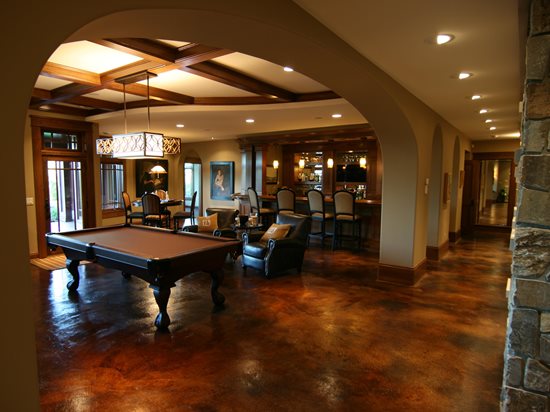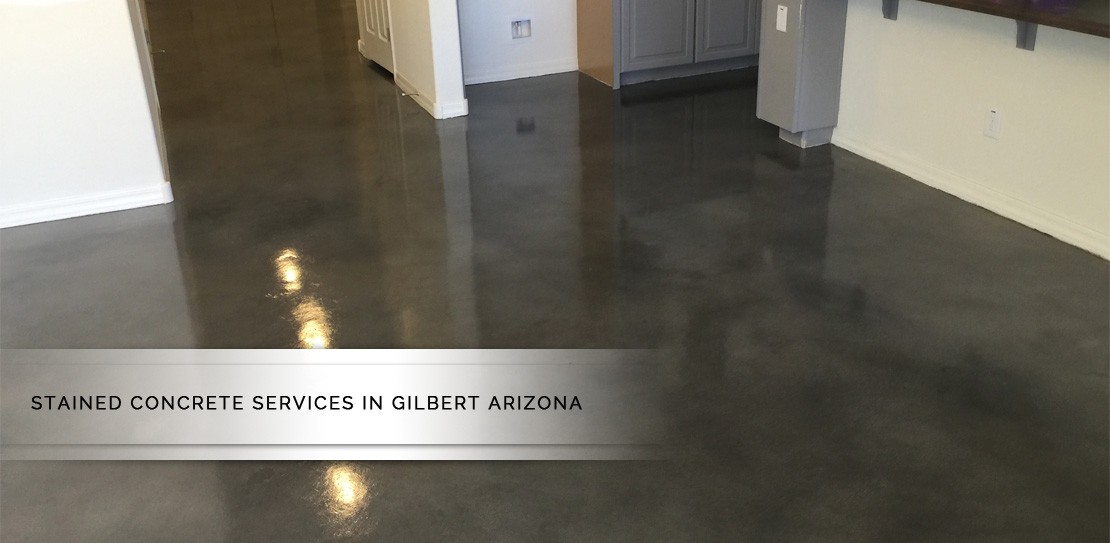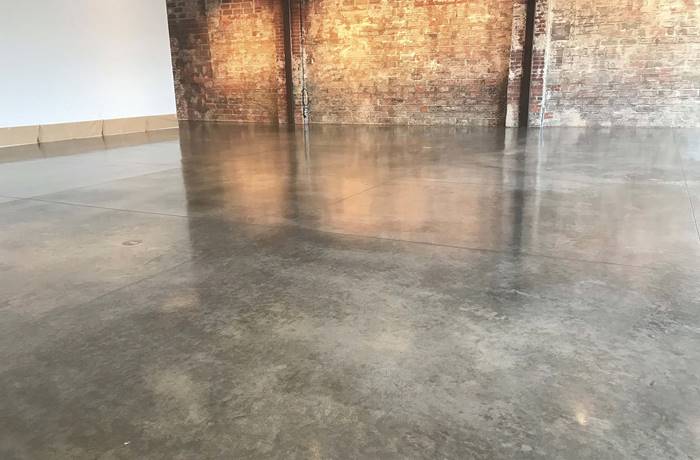Benefits of Interior-Stained Concrete Floors
If you’re looking to spruce up your living space and give it a unique, modern twist, you might want to consider the many benefits of these stylish floor treatments. Gone are the days when concrete floors were relegated to garages and industrial spaces. Today, interior-stained concrete floors have emerged as a chic and environmentally friendly alternative to traditional flooring options. Below are several benefits of interior-stained concrete floors:
- Versatility: One of the major benefits of interior stained concrete floors is their versatility. Stained concrete floors offer a wide range of design options, allowing homeowners to choose from various colors, patterns, and finishes. Whether you prefer a sleek and modern look or a more rustic and natural appearance, stained concrete floors can be customized to fit your aesthetic preferences.
- Durability: Concrete floors are known for their durability, and when properly stained and sealed, they can withstand heavy foot traffic, spills, and other daily wear and tear. Unlike other flooring options, stained concrete floors do not easily chip, scratch, or fade, making them a long-lasting and cost-effective choice for interior spaces.
- Low maintenance: Interior stained concrete floors require minimal maintenance compared to other flooring materials. Regular sweeping and occasional mopping with a neutral cleaner are usually sufficient to keep the floors clean and in good condition. Additionally, the stain and sealant used on the concrete floors create a barrier that prevents dirt, dust, and stains from penetrating the surface, making it easier to clean and maintain.
- Eco-friendly: Using stained concrete for interior flooring is an eco-friendly choice. Concrete is a sustainable material that can be recycled, reducing the need for new resources. Stained concrete floors also contribute to improved indoor air quality as they do not harbor allergens, mold, or mildew, which can be a concern with carpet or other flooring materials.
- Cost-effective: Interior stained concrete floors offer a cost-effective solution for homeowners. Compared to other flooring options, such as hardwood or tile, stained concrete floors are generally more affordable to install. Additionally, their durability and low maintenance requirements can save homeowners money in the long run, as they won’t need to be replaced or repaired as frequently.
- Temperature regulation: Concrete has the ability to absorb and retain heat, helping to regulate the temperature of the space. This can be particularly beneficial in areas with extreme weather conditions. In colder climates, stained concrete floors can help to keep the interior warmer, while in hotter climates, they can provide a cooler surface to walk on.
- Increased property value: Installing interior stained concrete floors can increase the value of a property. The versatility, durability, and aesthetic appeal of stained concrete floors can be attractive to potential buyers and may make a property stand out in the real estate market.

How to Choose the Right Stain for Your Interior Concrete Floors
When it comes to choosing the right stain for your interior concrete floors, there are several factors to consider. The right stain can enhance the beauty of your floors and provide a durable finish that can withstand daily wear and tear. Here are some important considerations to keep in mind:
Determine your desired look: Before choosing a stain, think about the look you want to achieve for your interior concrete floors. Stains are available in a wide range of colors and finishes, including translucent, semi-transparent, and solid. Consider the overall aesthetic of your space and choose a stain that complements it.
Assess the condition of your floors: Take a close look at the condition of your concrete floors. If they have any cracks, chips, or other imperfections, you may need to address these issues before applying a stain. There are stains available that can help camouflage minor imperfections, but major damage may require additional repairs.
Consider the level of maintenance required: Different stains have different levels of maintenance requirements. Some stains may require regular reapplication or the use of specific cleaning products. If you prefer a low-maintenance option, look for stains that offer long-lasting protection and are easy to clean.
Think about the level of durability needed: Interior concrete floors can experience heavy foot traffic, spills, and other forms of wear and tear. Consider the level of durability you need from your stain. Some stains offer high levels of protection against stains, scratches, and UV damage, while others may be more susceptible to wear over time.
Research different types of stains: There are two main types of stains for interior concrete floors: acid-based stains and water-based stains. Acid-based stains penetrate the concrete and create a variegated, mottled appearance, while water-based stains provide a more uniform color. Research the pros and cons of each type to determine which one is best for your needs.
Test the stain on a small area: Before applying the stain to your entire floor, it is recommended to test it on a small, inconspicuous area. This will allow you to see how the stain reacts with your concrete and how the color looks in your space. It is also a good opportunity to ensure that the stain meets your expectations.
Seek professional advice if needed: If you are unsure about which stain is best for your interior concrete floors, consider seeking professional advice. A concrete flooring specialist can assess your specific needs and recommend the most suitable stain for your space.
Steps to Prepare and Stain Interior Concrete Floors
Preparing and staining interior concrete floors can be a rewarding DIY project that can transform the look and feel of a space. Here are the steps to follow to achieve beautiful, stained concrete floors:
Clean the Surface: Before beginning the staining process, it is crucial to thoroughly clean the interior concrete floor. Remove any dirt, dust, or debris using a broom or vacuum cleaner. For stubborn stains or grease spots, use a mild detergent and water solution to scrub the surface clean. Rinse the floor thoroughly and allow it to dry completely before moving on to the next step.
Repair Any Damages: Inspect the concrete floor for any cracks, holes, or other damages. Fill these imperfections using a concrete patching compound or epoxy filler, following the manufacturer’s instructions. Smooth out the repaired areas using a trowel and allow them to dry completely before proceeding.
Etch the Surface: To ensure proper adhesion of the stain, it is necessary to etch the concrete floor. Etching creates a rough surface that allows the stain to penetrate and bond effectively. Use a concrete etching solution, applying it evenly over the entire floor according to the manufacturer’s instructions. Once applied, scrub the floor with a stiff-bristle brush to ensure thorough coverage. Rinse the floor thoroughly with water and allow it to dry completely.
Apply the Stain: Choose a high-quality concrete stain in the desired color and finish. Before applying the stain, ensure the floor is completely dry. Using a pump sprayer, roller, or brush, apply the stain evenly over the entire floor, working in small sections. Allow the first coat to dry according to the manufacturer’s instructions before applying subsequent coats if desired. For a more vibrant color, additional coats may be necessary.
Seal the Floor: Once the desired color is achieved and the stain has dried completely, it is crucial to seal the interior concrete floor. Choose a concrete sealer suitable for stained concrete floors and apply it using a roller or brush, following the manufacturer’s instructions. Apply multiple thin coats, allowing each coat to dry before applying the next. The sealer will protect the stain from wear and tear while enhancing its appearance.
Maintenance and Care Tips
Regular Cleaning:
To maintain the appearance and longevity of interior stained concrete floors, it is important to establish a regular cleaning routine. Sweep or vacuum the floor regularly to remove dirt, dust, and debris. Avoid using abrasive materials or stiff brushes that can scratch the surface of the stain.
Mopping Technique:
When mopping stained concrete floors, use a mild pH-neutral cleaner specifically formulated for concrete. Avoid harsh chemicals, vinegar, or ammonia-based cleaners, as they can damage the stain. Dilute the cleaner according to the manufacturer’s instructions and mop the floor using a soft mop or microfiber pad. Rinse thoroughly with clean water to remove any residue.
Stain Protection:
Interior stained concrete floors can benefit from the application of a protective sealer. Sealing the floor helps to enhance its stain resistance, durability, and overall appearance. Consult with a professional to determine the appropriate type of sealer for your specific stain and floor conditions. Apply the sealer according to the manufacturer’s instructions, ensuring even coverage and allowing sufficient drying time.
Avoid Harsh Chemicals:
To prevent damage to the stained concrete surface, avoid using harsh chemicals or cleaning agents on the floor. Acidic or abrasive substances, such as bleach, citrus cleaners, or ammonia, can erode the stain and compromise its integrity. Instead, opt for mild, pH-neutral cleaners specifically designed for use on stained concrete floors.
Furniture and Heavy Objects:
When moving furniture or heavy objects on interior stained concrete floors, use protective pads or furniture glides to prevent scratching or gouging. Avoid dragging heavy items across the floor, as this can cause damage to both the stain and the concrete surface. Lift and carry objects whenever possible to minimize the risk of impact.
Regular Maintenance Inspections:
Conduct regular maintenance inspections to identify any signs of wear, damage, or stains on the interior stained concrete floors. Promptly address any spills or stains by blotting them with a clean cloth or paper towel. For stubborn stains, consult a professional for appropriate stain removal techniques.
Preventive Measures:
Take preventive measures to minimize wear and tear on interior stained concrete floors. Use area rugs or mats in high-traffic areas, such as entryways or near sinks, to reduce the risk of scratches or stains. Place mats or trays under potted plants to catch any water or soil that may leak onto the floor.
Concrete Floors – Pros & Cons of Concrete Flooring – Concrete Network
Interior Residential Concrete Floors – Concrete Texturing
Interior Concrete Floors St. Paul – Minneapolis, MN Acid Stained
Concrete Stain the Perfect Flooring Solution SUNDEK San Antonio
Alternative Finishes for Interior Concrete Floors – Concrete Decor
Hardwood vs. Polished Concrete Flooring Broward.
Related Posts:








